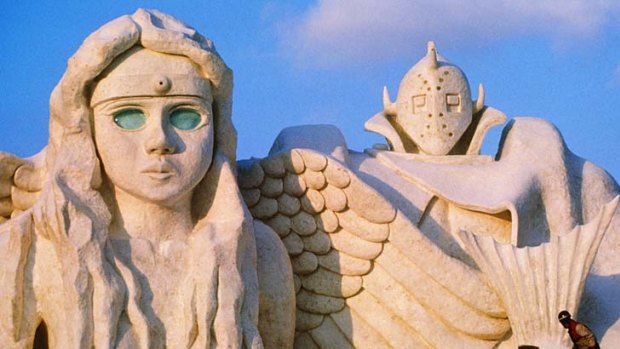
Frozen figures ... sculptures at Sapporo.Credit: Getty Images
Robbie Collin heads to Hokkaido to bathe in blizzard conditions and joins the crowds at Sapporo's snow festival.
It was never my intention to play charades naked on a hotel roof with an equally naked Japanese pensioner in the middle of a gale-force blizzard. That's just how things turned out. I was travelling to Sapporo to see the city's snow festival, in which residents and a handful of foreigners build elaborate sculptures in the streets and parks before eating their own body weight in barbecued meat washed down with enormous glasses of beer. Rail pass in hand, I had worked my way north from Tokyo to Hokkaido, the country's second-largest island.
After a five-hour trip via the Seikan Tunnel, which connects Hokkaido to the mainland, our train chugged into the bustling fishing port of Hakodate. I checked into the La Vista Hakodate Bay hotel (see hakodate.a-japan.eu) and went upstairs to use its rotenburo, a rooftop bath filled with mineral-rich water drawn from an underground hot spring. Hakodate is built on a low-lying isthmus that stretches to the slopes of an extinct volcano and is flanked by the ash-grey waters of the Tsugaru Straits.
It means a new weather system blows through every 30 seconds or so and in the time it had taken me to reach the top floor, the hotel had become engulfed by a snowstorm. A sign on the changing-room door gave warning that "in the event of inclement weather, the outdoor bath will be closed" but it wasn't, even though gales of sleet were blowing so hard the windows bulged inwards. I shed my clothes, scrubbed at a wash station and, clutching a facecloth-size towel, manfully gritted my teeth, slid open the door and minced across the rooftop in agony, my modesty towel flapping in soggy surrender.
I plopped into the steaming water with a groan. The blizzard was so ferocious I could barely see the roof's edge. An elderly gentleman, who must have been steeping there for some time, said something in Japanese. I grimaced my lack of comprehension, so he pointed into the storm and drew an isosceles triangle in the air. This was followed by a cross, and a frown of mock disgruntlement, as if to say, "Where's the mountain?" I smiled and shrugged theatrically. The old man looked delighted and instantly sketched out an oblong with an upwards spike at one end, before pointing back into the maelstrom.
I thought back to my guide book and wondered if he was pointing to the city's orthodox church, founded by Russian emissaries in 1859 on the flanks of the mountain.
Tentatively, I put my hands together in prayer and looked to my new friend for affirmation. I was right! He went on to mime an entire tour of Hakodate's finest attractions: the star-shaped fort of Goryokaku; the fish market; and the steep streets of the Motomachi district, where wooden houses are a curious hotchpotch of 19th-century Western and Eastern architecture (this last detail was from the guidebook - nobody's that good at miming).
The following morning I caught the train to Sapporo, where the snow festival was in full swing, and made for Odori Park in the middle of the city's orderly grid of tree-lined boulevards. Here, in 1950, a group of high school pupils built six snow sculptures, making a good enough job of it to establish an annual event that has since expanded to two further sites: Susukino, the nightlife district; and the grounds of the Tsudome exhibition centre. The festival now attracts about 2 million visitors a year, including teams of international sculptors.
I surveyed scale models towering above the crowd; cartoon characters rubbed subzero shoulders with humans, robots and animals. Two blocks from the city's television tower, lit up like a giant Christmas tree, was a ski jump from which snowboarders soared (the Niseko snowfields are near Sapporo) while a crowd watched, entranced, wisps of steam rising from the cups of hot chocolate and warm sake clasped between hands. Nearby, butter-drenched shellfish crackled on a barbecue and a phalanx of mobile kitchens served grilled sweetcorn doused in soy sauce, curry soup, steamed sweet potato dumplings and a kind of deconstructed lamb kebab called Genghis Khan, which came to Japan from Mongolia - unlike its namesake.
Old men and young women alike supped from plastic tankards of foaming golden beer (the city's famous Sapporo Beer Museum is housed in a venerable former 19th-century brewery with a cavernous beer hall attached). The atmosphere was as warm and genial as a hot spring bath and I soaked it all in as I walked south to Susukino in search of more food, ducked between ice sculptures into Ramen Alley and slurped a huge bowl of noodles in rich, scalding miso broth.
Outside, the sun sank beneath the mountains, the streets rang with happy voices and the ice sculptures shone with reflected neon. The thermometer on the noodle shop wall read six degrees below freezing, and I felt as warm as ever.
The Sapporo Snow Festival (Sapporo Yuki Matsuri) is from February 5-11, 2013. Qantas and Japan Airlines fly to Tokyo with connections to Hokkaido's New Chitose Airport. The JR airport express from New Chitose to JR Sapporo Station runs every 15 minutes and takes about 40 minutes. If coming by train from Tokyo, buy a rail pass. See japanrailpass.net.
- Telegraph, London
Sign up for the Traveller Deals newsletter
Get exclusive travel deals delivered straight to your inbox. Sign up now.